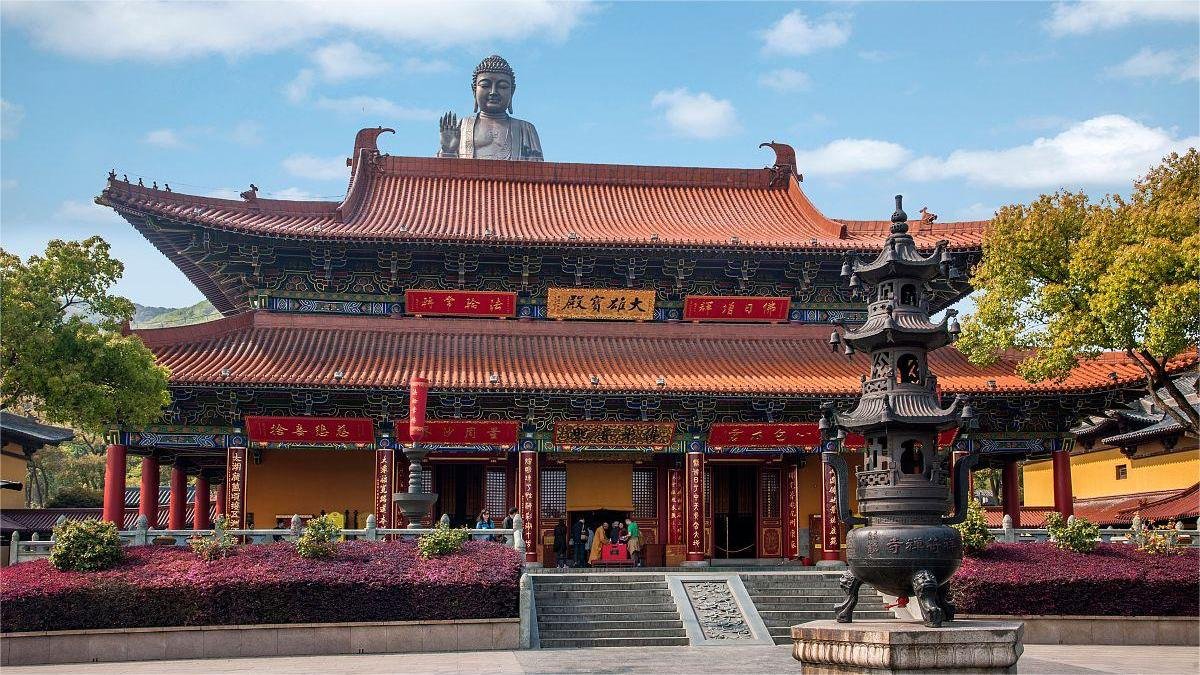Perched amidst the serene and picturesque Lingshan Buddhist Scenic Area at the southern foot of Qin Lu Peak in Wuxi, Jiangsu, China, Xiangfu Temple (祥符寺) stands as a testament to centuries of Buddhist devotion and architectural splendor. With a history that traces its roots back to the Tang Dynasty, this sacred site has weathered the dynastic transitions of the Song, Ming, and Qing eras, enduring periods of renovation and expansion to reach its present-day grandeur. In this article, we will delve into the rich history and exquisite features of Xiangfu Temple, a haven of spirituality and natural beauty.
Tang Dynasty Origins (627 AD)
The origins of Xiangfu Temple can be traced back to the Tang Dynasty, specifically during the reign of Emperor Taizong in the Zhenguan era (627 AD). It was during this time that a retired general named Hang Yun, who hailed from the Ma Ji Mountain region, decided to establish a temple upon his return to his hometown. Notably, Hang Yun had cultivated a close friendship with the renowned Tang Dynasty monk, Xuanzang.
Xuanzang, famous for his epic journey to India to retrieve Buddhist scriptures, had a vision during his travels. He saw the landscape at the southern foot of Qin Lu Peak resembling the spiritual Vulture Peak in India, which was closely associated with the Buddha’s teachings. Moved by this vision, Xuanzang declared the area as “Xiao Ling Shan,” meaning “Little Spiritual Mountain.” He instructed his disciple Kuiji to establish the first generation of the Cien Chan School (慈恩宗) at this sacred site.
Song Dynasty Revival (1009 AD)
In the Song Dynasty, during the Xiangfu era (1009 AD), Xiangfu Temple underwent a significant renovation and was renamed “Xiangfu Chan Yuan” or “Xiangfu Zen Monastery.” The temple continued to flourish and was officially established in the fourth year of the Xuanhe era (1124 AD).
Ming and Qing Dynasty Renovations
Throughout its history, Xiangfu Temple underwent various renovations and expansions. In the Ming Dynasty, during the Hongwu era (1371 AD), extensive repairs were carried out to maintain its architectural splendor. In the 15th century, during the Zhengtong era (1447 AD), the temple received the great honor of being bestowed with a copy of the Tripitaka, a collection of Buddhist scriptures.
The 16th century witnessed further enhancements, including the reconstruction of the main hall in the 30th year of the Jiajing era (1553 AD) and the restoration of the scripture hall in the fifth year of the Longqing era (1583 AD). Additionally, in the first year of the Wanli era (1574 AD), a new pagoda was erected, further enhancing the temple’s spiritual significance. In the fourth year of the Tianqi era (1626 AD), the magnificent Dabeidian Hall was built, marking another significant chapter in the temple’s history.
Qing Dynasty Prosperity (1669 AD)
During the Qing Dynasty, in the year 1669 (Dingwei year of the Kangxi era), Xiangfu Temple enjoyed a period of prosperity and extensive reconstruction. Su Zi Jing, a native of Haiyang, donated generously to fund the reconstruction efforts. The reconstruction project spanned nine years and saw the establishment of the Linji Zen School (临济宗) in the temple, attracting numerous monks and followers. During this time, the temple became known as “Shenjun Temple,” signifying its divine and majestic stature.
The Trials of War and Rebirth (1861 AD)
The 19th century brought unprecedented challenges to Xiangfu Temple. In the year 1861 (Gengshen year of the Xianfeng era), the temple fell victim to the ravages of war, and its precious Buddhist scriptures were lost to the flames. However, amidst the devastation, several structures including the Tianwang Hall, the storage room, and the kitchen miraculously survived.
Revival in the Republic Era (1914 AD)
In the year 1914, during the third year of the Republic of China, Xiangfu Temple was rebuilt, and it reverted to its original name, “Xiangfu Temple.” This marked a turning point in the temple’s history as it once again emerged as a center of spirituality and cultural heritage.
Resilience in the Face of Adversity (20th Century)
The 20th century brought new challenges as Xiangfu Temple faced the destructive “Three Alls Policy” implemented by Japanese forces during their occupation of Ma Ji Mountain in 1938. Many of the temple’s buildings were severely damaged during this period.
However, the spirit of Xiangfu Temple prevailed, and in the 1970s, the temple was once again rebuilt, with a monumental addition. A towering bronze statue of Shakyamuni Buddha, standing at a remarkable height of 88 meters, was erected on the hill behind Xiangfu Temple, making it one of the tallest Buddha statues in the world.
The Contemporary Xiangfu Temple
Today, Xiangfu Temple spans over 400 acres of land and is part of the Lingshan Buddhist Scenic Area. The temple complex ascends the mountainside, featuring key structures such as the Reflecting Wall, Mountain Gate, Heavenly Kings Hall, Bell and Drum Tower, Great Hall of Mahavira, and the colossal statue of Shakyamuni Buddha. The temple’s layout harmoniously blends with the natural contours of the landscape, creating a serene and awe-inspiring environment.
Flanking the main structures are meditation halls, monk quarters, and auxiliary buildings, all meticulously designed to complement the temple’s grandeur. The winding paths through lush greenery, the gradual ascent up the mountain, and the layered architecture create a truly magnificent spectacle.
In addition to its spiritual significance, Xiangfu Temple also offers various amenities and services, all thoughtfully integrated into the landscape. Its idyllic setting amidst clouds and water accentuates the temple’s natural beauty, providing visitors with a profound sense of peace and tranquility.




